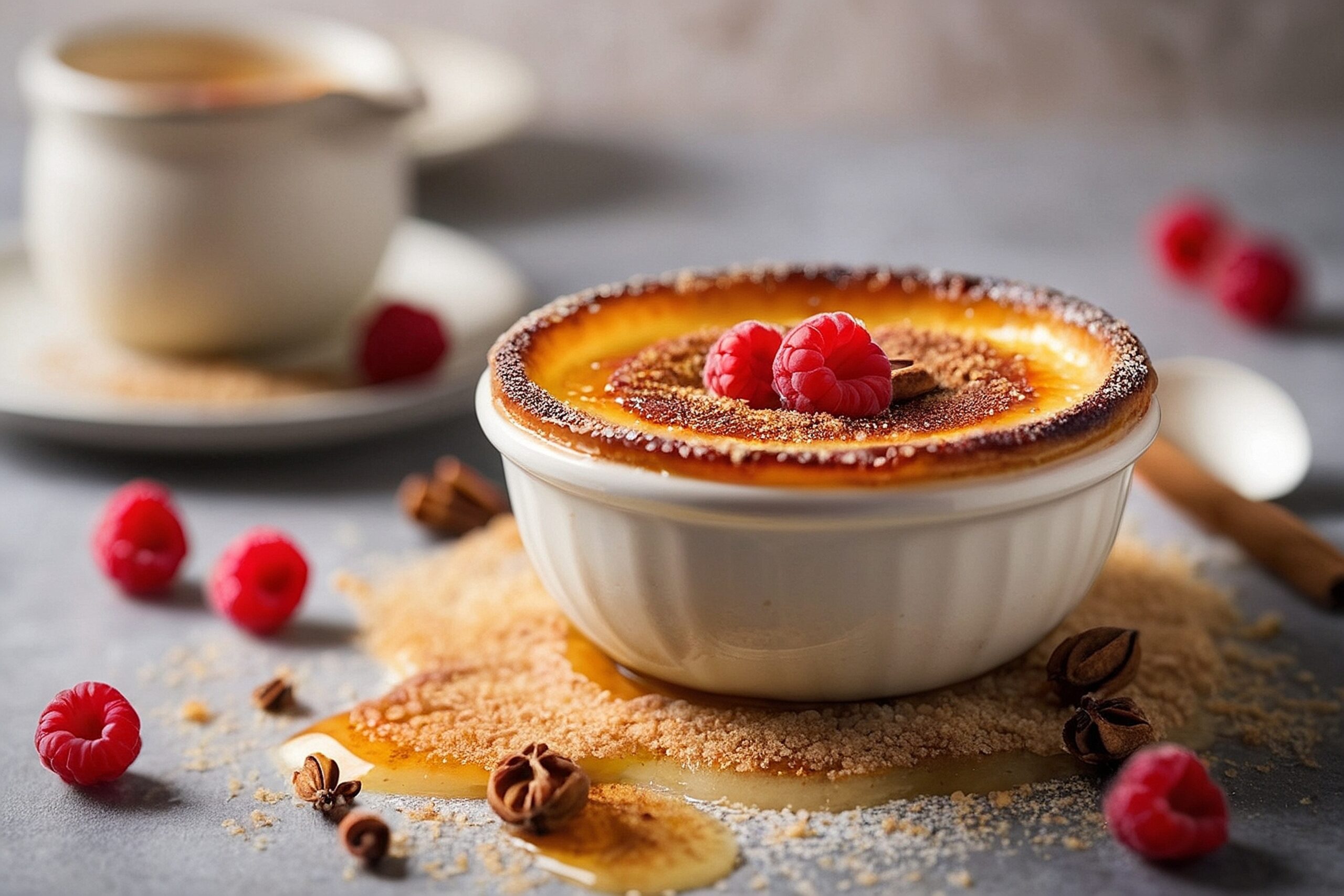Crème brûlée is one of those desserts that instantly impresses. The creamy custard base topped with a crackling layer of caramelized sugar is not just delicious—it’s downright luxurious. But here’s a question that might have crossed your mind: Do you have to use ramekins for crème brûlée? Maybe you’re short on ramekins, or perhaps you just want to try something different. Let’s dive into this creamy, sugary dilemma and see if ramekins are truly necessary or if there are other ways to get that perfect crème brûlée at home.
What Is Crème Brûlée?
Before we start discussing ramekins, let’s take a moment to talk about the star of the show: crème brûlée. This French dessert, whose name means “burnt cream,” consists of a rich custard base topped with a contrastingly crisp layer of caramelized sugar. It’s a dessert that’s as much about texture as it is about flavor. The combination of silky-smooth custard and the crunchy sugar topping is what makes crème brûlée so irresistible.
Traditionally, crème brûlée is baked in individual ramekins—small, shallow dishes that are perfect for single servings. But why are ramekins the go-to for this dessert, and could you swap them out for something else?
Why Are Ramekins Traditionally Used?
Ramekins have long been the vessel of choice for crème brûlée, and it’s not just because they look nice (though they do). Here are a few reasons why ramekins are traditionally used:
- Size and Shape: Ramekins are typically small and shallow, which is ideal for crème brûlée because it allows for the perfect custard-to-sugar ratio. The shallow depth also ensures that the custard cooks evenly without overcooking the edges while the center remains underdone.
- Material: Most ramekins are made from ceramic, which retains and distributes heat evenly. This helps the custard cook at a consistent temperature, resulting in that silky texture we all love.
- Presentation: Let’s be honest, crème brûlée served in a ramekin just looks elegant. The small, individual portions feel special and indulgent—perfect for impressing guests or treating yourself.
But just because ramekins have been the traditional choice doesn’t mean they’re the only option.
Can You Make Crème Brûlée Without Ramekins?
The short answer is: absolutely! You don’t have to use ramekins for crème brûlée. If you’re in a pinch or simply want to experiment, there are plenty of alternatives that can work just as well. However, there are some things to keep in mind when choosing a different container.
Alternative Containers to Consider
- Mason Jars: These are a popular alternative because they’re readily available and come in various sizes. However, because they’re often taller than ramekins, you’ll need to adjust the cooking time to ensure the custard sets properly without burning the top.
- Tea Cups: If you’re looking for something a bit fancier, tea cups can be a charming option. Just make sure they’re oven-safe. The deeper shape might require a lower oven temperature and a longer cooking time.
- Shallow Bowls: If you have some shallow, oven-safe bowls lying around, these can work too. The wider surface area means your crème brûlée will have more caramelized sugar on top, which is never a bad thing.
- Glass Baking Dishes: For a more rustic presentation, you can use a glass baking dish and make a larger, family-style crème brûlée that can be scooped out for serving.
Best Non-Ramekin Alternatives
So, which of these alternatives is the best? It really depends on what you’re looking for. Here are my top picks based on ease of use, availability, and final presentation:
- Mason Jars: Ideal for individual servings with a rustic twist. The jars are easy to find, and they come with lids, so you can store any leftovers without transferring them to another container.
- Shallow Bowls: These work well if you want more surface area for the caramelized sugar. Just keep an eye on your cooking time to prevent the edges from overcooking.
- Tea Cups: Perfect for a more elegant presentation, especially if you’re serving guests. Just make sure to adjust the temperature to prevent overcooking.
- Glass Baking Dish: Great for a family-style dessert. This is the way to go if you’re making crème brûlée for a crowd and don’t want to fuss with individual servings.
How to Adjust Your Recipe When Not Using Ramekins
If you’re using an alternative container, there are a few adjustments you’ll need to make to ensure your crème brûlée turns out perfectly.
1. Adjust the Cooking Time
Different containers will cook at different rates. For example, a deeper container like a mason jar will take longer to cook than a shallow ramekin. Start by adding 5-10 minutes to your baking time and keep a close eye on the custard. You’ll know it’s done when it’s set around the edges but still slightly jiggly in the center.
2. Modify the Oven Temperature
If you’re using a container that’s deeper than a ramekin, consider lowering the oven temperature by 10-15 degrees Fahrenheit to prevent the top from browning too quickly while the custard cooks through.
3. Pay Attention to Portion Sizes
Ramekins are typically 4-6 ounces, but if you’re using a different container, you may need to adjust the amount of custard you pour into each one. Aim for a thickness similar to that of a ramekin custard—about 1 to 1.5 inches deep.
Tips for Perfect Crème Brûlée Regardless of the Container
No matter what container you’re using, there are a few tips that will help you achieve the perfect crème brûlée every time:
- Use a Water Bath: Even if you’re not using ramekins, a water bath is essential for cooking crème brûlée. It ensures gentle, even cooking, which is crucial for that silky-smooth texture. Place your containers in a large baking dish and fill it with hot water until it reaches halfway up the sides of your containers.
- Strain the Custard: After mixing your custard, strain it through a fine-mesh sieve before pouring it into your containers. This will remove any air bubbles and ensure a smooth, creamy texture.
- Caramelize the Sugar Just Before Serving: For the best results, sprinkle the sugar on top of the custard and caramelize it with a kitchen torch just before serving. This way, you get that perfect contrast between the crisp sugar top and the creamy custard underneath.
Popular Crème Brûlée Variations
Once you’ve mastered the classic crème brûlée, why not try some fun variations? Here are a few ideas to get you started:
- Chocolate Crème Brûlée: Add melted dark chocolate to your custard base for a rich, indulgent twist on the classic.
- Coffee Crème Brûlée: Infuse your custard with strong brewed coffee or espresso for a deliciously bold flavor.
- Fruit-Infused Crème Brûlée: Try adding a layer of fruit puree, like raspberry or mango, at the bottom of your containers before pouring in the custard. The fruity surprise at the bottom adds a delightful contrast to the creamy custard.
- Flavored Crème Brûlée: Experiment with different flavors by infusing your cream with ingredients like vanilla bean, cinnamon, or even lavender before making the custard.
If you’re looking for more dessert ideas, why not check out this Easy Iced Oatmeal Cookies Recipe – Soft, Chewy, Delicious for a tasty treat?
Conclusion
So, do you have to use ramekins for crème brûlée? Not necessarily! While ramekins are the traditional choice, there are plenty of alternative containers that can work just as well. Whether you opt for mason jars, tea cups, or even a glass baking dish, the key is to adjust your recipe accordingly to ensure that your custard cooks evenly and your sugar topping caramelizes perfectly. Crème brûlée is a versatile dessert that can be adapted to suit your needs and your kitchen equipment, so don’t be afraid to get creative and experiment with different containers. Who knows—you might just discover a new favorite way to serve this classic dessert!
FAQs
- Can I use a regular baking dish instead of ramekins for crème brûlée?
- Yes, you can use a regular baking dish, but be sure to adjust the cooking time to prevent overcooking.
- What if I don’t have a kitchen torch to caramelize the sugar?
- You can use your oven’s broiler, but watch closely to avoid burning the sugar.
- Is it okay to make crème brûlée ahead of time?
- Absolutely! Just wait to caramelize the sugar until right before serving to keep the top crisp.
- Can I make a large batch of crème brûlée in one dish?
- Yes, but be prepared for a longer cooking time, and make sure to use a water bath.
- What is the best sugar to use for the caramelized top?
- Granulated sugar works best, as it melts evenly and forms a nice, crisp layer.
- Can I flavor the custard with something other than vanilla?
- Definitely! Try infusing the cream with coffee, citrus zest, or spices for a unique twist.
- Do I have to use heavy cream in crème brûlée?
- Heavy cream is traditional, but you can substitute half-and-half for a lighter version.
- What’s the best way to store leftover crème brûlée?
- Cover the dishes with plastic wrap and refrigerate. Enjoy within 2-3 days for the best flavor and texture.

